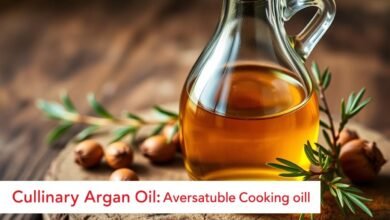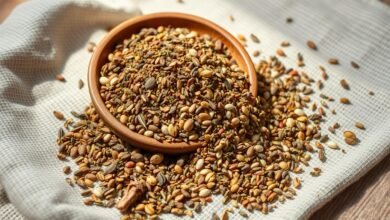
cinnamon superfood — You may have felt a small thrill when a familiar spice showed up in health headlines. It can feel personal when a kitchen staple suddenly promises more than taste. You want clear facts, not hype.
Over time, the cinnamon conversation grew as people searched for everyday food that might help health. Early research and studies offered hints: plant compounds, antioxidant effects, and possible impacts on blood and sugar.
The bark is peeled, dried, and sold as sticks or ground powder. One teaspoon is low in calories and adds fiber and flavor. Lab work and small trials suggest modest benefits, but long-term evidence on disease outcomes is limited.
This section will guide you through how this spice moved from the pantry into wellness headlines, what the research really shows, and how to use it sensibly in your routine without overpromising results.
Key Takeaways
- You’ll see why the spice rose in popularity and what drove the wellness buzz.
- Research shows modest effects on blood and sugar in some people, but findings are mixed.
- Cinnamon contains antioxidants and has anti-inflammatory properties in lab studies.
- The term superfood has no official definition and can be misleading.
- Use the spice for taste and small potential benefits, not as a disease cure.
- More long-term, randomized trials are needed to confirm health benefits.
How cinnamon became labeled a “superfood” in the early 2000s
In the early 2000s, a familiar kitchen spice moved from simple seasoning to headline-making wellness talk.
The shift happened quickly. Media outlets and blogs picked up small lab reports and short human trials. Those pieces often skipped study limits and focused on appealing headlines.
From kitchen staple to wellness headline: what changed
From kitchen staple to wellness headline
You saw the spice promoted as a quick route to better blood sugar, cholesterol, and more. Early signals from labs and pilot trials were repeated until the idea caught on with many people.
Media, blogs, and preliminary studies: the hype cycle
Small studies and press summaries drove most of the buzz. Short-term research was amplified without clear context, which created a hype cycle faster than rigorous proof could follow.
Why the term “superfood” has no official definition
The label is a marketing term, not a scientific one. There is no regulated definition, so usage varies by outlet and influencer. Experts urge you to view early findings as signals, not definitive evidence.
- You can use the spice in food for flavor and modest benefits.
- Relying on it for medical outcomes goes beyond current evidence.
- Cautious optimism — valuing studies but waiting for stronger proof — is the best stance.
| Driver | What it claimed | Study type cited | Reality check |
|---|---|---|---|
| Media coverage | Improved blood markers | Short trials, press releases | Promising but limited evidence |
| Blogs & influencers | Easy health wins | Lab studies, anecdotes | Not conclusive for people |
| Early research | Antioxidant effects | Pilot human studies & lab work | Signals that need larger trials |
The history behind the spice: from ancient trade to modern wellness
For centuries, traders prized the fragrant inner bark as a rare and valuable commodity. You can trace how a pantry staple moved through markets, kitchens, and healing traditions over time.
What it is: inner bark, rolled sticks, and ground powder
The product starts as inner bark from small evergreen trees. Producers peel the bark, dry it into curled sticks, and mill some into fine powder for easy use. You know its warm aroma and pleasant flavor when you smell or taste it in baked goods and savory dishes.
Traditional uses in food and medicine across cultures
Across regions, people used this spice in food and in traditional medicine for soothing and antibacterial needs. Its aroma comes from oils like cinnamaldehyde, which early healers prized long before labs studied mechanisms.
- You can picture the rolled bark or reach for powder when cooking.
- The warm, sweet-woody taste lifts dishes without extra salt or sugar.
- Historical trade and daily use explain why it remains a pantry essential.
Evidence check: what research suggests cinnamon may do
Researchers have focused on polyphenols and essential oils to explain possible benefits.
Antioxidants and anti-inflammatory effects
Polyphenol antioxidants in the bark show anti-inflammatory effects in lab work. These compounds help explain why researchers suggest cinnamon may protect cells from oxidative stress.
Blood sugar control and insulin sensitivity
Human trials report modest drops in fasting blood sugar for some people with poor control. Results are mixed, so you should view this as a possible, not guaranteed, change.
Heart signals: cholesterol and blood pressure
Short-term studies link intake to improved cholesterol and small reductions in blood pressure. Larger, longer trials are needed before clinical advice changes.
Early-stage areas: infections, brain, and cancer
Antibacterial and antifungal actions come from cinnamaldehyde in lab and animal work. Data on brain pathways and cancer are mostly in cells or animals, not decisive for people.
| Area | Type of evidence | What it suggests |
|---|---|---|
| Antioxidants | Lab studies | May reduce inflammation and protect cells |
| Blood sugar | Small human trials | Modest lowering of fasting blood sugar in some people |
| Heart markers | Short trials | Improvements in cholesterol and lower blood pressure short-term |
| Infections / cancer / brain | Animal & cell studies | Early signals; not proven in humans |
- Use the spice for taste and possible benefits, not as treatment.
- Track your response and consult your clinician for medical decisions.
Safety first: types of cinnamon, coumarin content, and smart amounts

Not all varieties are equal; some carry higher chemical content that matters for health. Choose the right type and keep portions sensible so you enjoy flavor without undue risk.
Ceylon vs. Cassia: why the difference matters
Ceylon (true variety) has lower coumarin content and is a better choice if you plan frequent use. Most supermarket jars are Cassia, which contains more coumarin and raises risk if consumed in large amounts over time.
Suggested culinary amounts and who should be cautious
For most adults, about one teaspoon per day as a culinary spice is considered safe. Children should have less.
If you take medicine for diabetes, heart, or liver conditions, talk with your clinician first. Large amounts can affect blood sugar and interact with prescribed treatment.
Supplements, interactions, and why “more” isn’t better
High-dose supplements are not standardized or FDA-approved, so dose and purity are uncertain. Rare allergic contact dermatitis can occur, too.
- Prioritize Ceylon for daily use to lower coumarin risk.
- Keep amounts modest—about a teaspoon daily for most adults.
- Consult your clinician if you use medicine for blood sugar, heart, or liver issues.
- Use the spice as a flavoring, not as a replacement for medicine.
| Type | Coumarin content | Best use |
|---|---|---|
| Ceylon | Low | Frequent culinary use |
| Cassia | Higher | Occasional seasoning |
“Cinnamon superfood” claims vs. reality
Controlled studies and kitchen use live in very different worlds. Lab research often tests concentrated extracts or high doses that you won’t reach by sprinkling a spice on your morning oats.
When the lab doesn’t match everyday life
Highly controlled trials report notable changes when researchers use large amounts. In those settings, some data show that research suggests cinnamon can affect pathways tied to glucose.
But real-world portions are small. Daily cooking doses rarely produce the same magnitude of change seen in studies. That means evidence for clear clinical benefits remains limited.
Using cinnamon to reduce added sugar without overdoing it
You can use the spice to boost flavor and help lower blood sugar spikes by cutting added sugars in coffee, yogurt, and baked goods. This is a safe, practical step toward better blood sugar control.
A few practical points:
- Remember studies often use extracts or high doses; your kitchen use will not mirror those effects.
- Avoid high-dose supplements marketed for metabolic control—dosage is inconsistent and can interact with diabetes meds.
- Modest culinary use can fit into heart-healthy habits and may help you reduce blood pressure when combined with diet and movement.
- Track how your body responds and lean on your clinician for medical decisions about glucose or blood pressure control.
Practical ways you can use cinnamon for taste and potential benefits

A few simple swaps can add warm flavor to everyday meals while trimming excess sugar and calories.
Sweet and savory ideas: Stir ground powder into yogurt, oats, or smoothies to boost taste and cut back on added sugar in simple recipes. Dust fruit with a pinch for a quick flavor lift that feels indulgent but adds little sugar.
For savory food, bloom the spice in oil before adding vegetables, or toss it into curries and stews for depth. Use bark sticks to simmer in broths, mulled cider, or slow-cooked dishes to infuse warm aroma without strong grit.
Daily use tips: Divide practical amounts—about one teaspoon per day for most adults—across meals if you like. Choose powder for quick mixing and bark for infusions, and store both airtight, away from heat and light to preserve fragrance and antioxidants.
- Fold it into baking blends with ginger or nutmeg for cozy recipes that need less sugar.
- Pair with protein and fiber to support steadier blood sugar responses as part of a balanced diet.
- Prep spice-forward recipes on the weekend—like a cinnamon-rubbed salmon or cinnamon tea—so you can add flavor during busy days.
| Use | Form | Why it helps |
|---|---|---|
| Yogurt, oats, smoothies | Powder | Mixes evenly; boosts taste so you reduce added sugar |
| Curries, stews, rubs | Powder or toasted | Releases oils in warm fat for deeper savory flavor |
| Tea, cider, broths | Bark sticks | Slow infusion gives rounded aroma without gritty texture |
| Snacks & baking | Powder | Makes better-for-you choices feel satisfying and cozy |
Cinnamon superfood: a balanced list of health benefits to know
Small, regular additions to meals can yield modest, measurable shifts in health markers over time. Below is a clear, balanced look at what research and tradition suggest.
May help lower blood sugar in some contexts
You may see modest support for blood sugar when the spice is part of an overall healthy pattern. Short trials report lower fasting blood sugar for some people, though results vary and are not a substitute for medical care.
May improve markers tied to blood pressure and cholesterol
Some studies suggest short-term reductions in blood pressure and favorable shifts in LDL cholesterol and triglycerides. These changes may improve heart risk factors, but sustained outcomes need more time and larger studies.
Anti-inflammatory and antioxidant support
The bark contains polyphenols and antioxidants that show anti-inflammatory effects in lab work. These compounds help protect cells and are a core reason for interest in health benefits.
Potential gut and oral health benefits
There is preliminary evidence of prebiotic-like effects that may support digestion. Traditional use for oral hygiene aligns with antimicrobial actions seen in lab studies.
- You can use small amounts consistently and pair the spice with fiber and protein to make benefits more likely.
- Keep expectations realistic for brain and cancer topics; signals in cells and animals need human confirmation.
- View these benefits as additive—supportive of overall diet, sleep, and movement—not curative.
| Area | Evidence type | Likely effect |
|---|---|---|
| Blood sugar | Small human studies | May lower fasting blood sugar modestly |
| Cholesterol & BP | Short trials | May improve cholesterol and reduce blood pressure short-term |
| Gut & oral | Lab & traditional use | Possible prebiotic and antimicrobial support |
Bottom line: These health benefits are plausible and modest. Use the spice in recipes you enjoy while you wait for stronger human data and keep an eye on risk if you use large amounts or supplements.
Conclusion cinnamon superfood
Keep it simple: you can enjoy this spice daily for flavor and modest health upside while staying realistic about claims.
Use about one teaspoon per day for most adults and pick Ceylon for frequent use because of lower coumarin content. Evidence from research, studies, and trials shows modest signals for lower blood sugar and some heart markers, but not firm proof to prevent disease.
Prefer whole food swaps that help control added sugar in your diet. Avoid high-dose supplements and check with your clinician if you have blood or medication problems.
In short, treat it as a tasty tool that makes healthy food easier to repeat. Learn more about its health benefits and choose the type and content that fit your routine.



